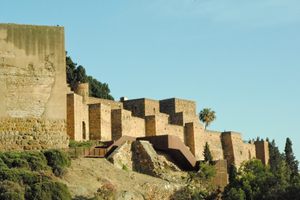“Alcazaba” is the Spanish rendering of “the citadel” in Arabic, which is why Málaga’s Alcazaba is one of many in Spain. Like most, the monumental structure in Málaga is the product of many centuries of addition, modification, embellishment, and destruction.
Although historical texts mention earlier fortresses in its current location, the Alcazaba as we know it was primarily built in the 11th century and then significantly improved in the 13th and 14th centuries by a series of small Moorish kingdoms, or “taifas,” that controlled Málaga after the fall of the powerful caliphate based in Córdoba.
When the city fell to the troops of Ferdinand and Isabella in 1487 after a siege of over three months, it became the residence of the crown’s local military governor. As the centuries passed, the Alcazaba’s importance as an administrative center diminished, and it served a variety of functions, including as an artillery outpost and prison. Its condition deteriorated significantly following an earthquake in 1680 and a French naval bombardment in 1693. By the end of the 18th century, it had been occupied by the townsfolk, becoming a marginal and picturesque residential neighborhood. It remained that way, partially hidden by the houses of local residents, until 1931, when it was declared a national monument.
The Alcazaba’s rehabilitation was initially directed by the same architect responsible for restoring the Alhambra in Granada, Leopoldo Torres Balbás. He took a historicist approach, seeking to restore the structure’s appearance as faithfully as possible during the time of the Moors. When construction teams undertook the removal of the neighborhood’s houses, they were happy to discover that residents had often simply covered up or walled off the remains of arches and columns — cheaper than demolishing and removing them entirely — thereby preserving these features for posterity. What visitors explore today is the result of the restorations carried out from the 1930s to the 1960s, which combined the remains of the original structure with reconstructions informed by archaeological evidence and historical drawings.
A visit inside the Alcazaba’s formidable walls reveals lush gardens and numerous fountains, harmoniously combining manmade and natural elements. The monument’s highlights include the arched doorways of a series of original towers leading up into the fortress’s residential interior, some of which incorporate columns from the ruins of the adjacent Roman theater. There’s also the Patio de las Armas, a small plaza with a fountain and garden overlooking the port of Málaga, and the upper palace, featuring its own water-cooled interior courtyards, elegant arches, and numerous other intricately detailed decorative elements.
